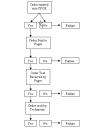Computerized Provider Order Entry with Pager Notification Improves Efficiency in STAT Radiographic Studies and Respiratory Treatments
- PMID: 23616826
- PMCID: PMC3631887
- DOI: 10.4338/ACI-2009-10-RA-0004
Computerized Provider Order Entry with Pager Notification Improves Efficiency in STAT Radiographic Studies and Respiratory Treatments
Abstract
Background: The use of computerized provider order entry (CPOE) has been widely linked to improvements in patient safety. We hypothesized that electronic routing of CPOE-generated orders through individual pagers would improve the efficiency of STAT radiographic studies and respiratory treatments.
Methods: The study was conducted in two periods before and after implementing pager notification of STAT orders. In the Baseline Period, CPOE-generated STAT orders were communicated to radiology technicians or respiratory therapists through the use of printed orders, manual paging and/or telephone communication. The time to process the order and deliver a radiology result or respiratory treatment was tracked. In the Intervention Period CPOE-generated STAT orders were electronically routed to the radiology technician's or respiratory therapist's pager. During both time periods, clinicians completed user satisfaction surveys.
Results: Using pager notification, there was a significant reduction in radiology technician arrival time (16.8±2.1 vs 7.9±0.7 mins, p<0.001). Similarly there was a significant reduction in the cumulative time required to capture the radiographic image, image availability in the picture archiving and communication system (PACS) and the verbal report from the radiologist (p<0.05). The time required in obtaining a preliminary or final radiographic written report and the total cycle times were not significantly reduced. For STAT respiratory therapy orders there was a significant reduction in the mean time from ordering to administration of respiratory therapy treatments (124.7±14.1 vs 49.8±11.4 minutes, p<0.01). Radiologists, respiratory therapists and ordering clinicians reported improved satisfaction after implementation of pager notification.
Conclusion: Computer-generated orders for STAT radiographic studies and respiratory treatments can be carried out significantly faster through the use of direct pager notification. The implementation of this process has resulted in improved care delivery and widespread clinician satisfaction.
Keywords: Care orders; Computerized provider order entry; Efficiency; Radiology; Respiratory therapy.
Figures




Similar articles
-
Automated examination notification of emergency department images in a picture archiving and communication system.J Digit Imaging. 2001 Jun;14(2 Suppl 1):143-4. doi: 10.1007/BF03190319. J Digit Imaging. 2001. PMID: 11442076 Free PMC article.
-
An Electronic Health Record Order Entry-Enabled Educational Intervention Is Not Effective in Reducing STAT Inpatient Radiology Orders.J Am Coll Radiol. 2019 Aug;16(8):1018-1026. doi: 10.1016/j.jacr.2019.01.033. Epub 2019 May 8. J Am Coll Radiol. 2019. PMID: 31078428
-
Efficiency Gains with Computerized Provider Order Entry.In: Henriksen K, Battles JB, Keyes MA, Grady ML, editors. Advances in Patient Safety: New Directions and Alternative Approaches (Vol. 4: Technology and Medication Safety). Rockville (MD): Agency for Healthcare Research and Quality (US); 2008 Aug. In: Henriksen K, Battles JB, Keyes MA, Grady ML, editors. Advances in Patient Safety: New Directions and Alternative Approaches (Vol. 4: Technology and Medication Safety). Rockville (MD): Agency for Healthcare Research and Quality (US); 2008 Aug. PMID: 21249961 Free Books & Documents. Review.
-
A computerized order entry system was adopted with high user satisfaction at an orthopedic teaching hospital.HSS J. 2014 Feb;10(1):52-8. doi: 10.1007/s11420-013-9377-1. Epub 2014 Jan 9. HSS J. 2014. PMID: 24482622 Free PMC article.
-
Computerized follow-up of discrepancies in image interpretation between emergency and radiology departments.J Digit Imaging. 1998 Aug;11(3 Suppl 1):18-20. doi: 10.1007/BF03168250. J Digit Imaging. 1998. PMID: 9735425 Free PMC article. Review.
Cited by
-
Improving ACGME Compliance for Obstetric Anesthesiology Fellows Using an Automated Email Notification System.Appl Clin Inform. 2021 May;12(3):479-483. doi: 10.1055/s-0041-1730323. Epub 2021 May 26. Appl Clin Inform. 2021. PMID: 34041735 Free PMC article.
-
Development and evaluation of a comprehensive clinical decision support taxonomy: comparison of front-end tools in commercial and internally developed electronic health record systems.J Am Med Inform Assoc. 2011 May 1;18(3):232-42. doi: 10.1136/amiajnl-2011-000113. Epub 2011 Mar 17. J Am Med Inform Assoc. 2011. PMID: 21415065 Free PMC article.
References
-
- Kohn L, Corrigan J, Donaldson M, eds. To err is human: building a safer health system. Washington, DC: National Academy Press, 1999 - PubMed
-
- The Leapfrog Group Available athttp://www.leapfroggroup.orgaccessed Feb 5, 2010
-
- Teich JM, Merchia PR, Schmiz JL, Kuperman GJ, Spurr CD, Bates DW. Effects of computerized physician order entry on prescribing practices. Arch Intern Med. 2000;160:2741-7 - PubMed
-
- Bates DW, Leape LL, Cullen DJ, Laird N, Petersen LA, Teich JM, et al. Effect of computerized physician order entry and a team intervention on prevention of serious medication errors. JAMA 1998;280:1311-16 - PubMed
LinkOut - more resources
Full Text Sources

